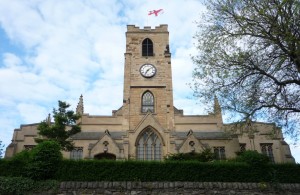
Formerly St Michael and All Angels Bishopwearmouth or Bishopwearmouth Parish Church, was first built around 900AD but due to many alterations little remains of the earlier constructions. The church served the majority of the area south of the River Wear and came under the jurisdiction of the Bishop of Durham – hence Bishopwearmouth. On January 11th 1998 the church was inaugurated as Sunderland Minster by Rt Rev Michael Turnbull, Bishop of Durham. The Minster aims to be supportive of ecumenical, industrial, University and other educational and leisure activities. It provides a meeting place for people from all over the City as well as a centre of worship on a daily basis. The church was once again renamed on Tuesday May 1st 2007 as the Minster Church of St Michael & All Angels and St Benedict Biscop, to commemorate it’s new status as an extra parochial place of worship.
THE CHANCEL
The Stained Glass Window depicting Christ in Glory contains the words of the Creed, the Borough of Sunderland coat of arms, St Michael slaying the dragon and the historical figure of St. Nicholas, Bishop of Myra and patron saint of sailors. The window was designed in 1950 to replace one damaged by enemy action during World War II.
Arches on the south side of the altar were originally seats but a raised floor now partially hides them. The wooden door on the north side was an aumbry for the reserved Sacrament. The small sculptured faces are thought to be as early as 14th century.
Staff, students and parents of Christ’s School, Richmond, Surrey designed one of the Altar Frontals which forms a set with the hangings, sometimes in place in the Bede Chapel. Christ’s is one of only a few ecumenical RC/CE secondary schools in the country.
The Organ built and maintained by Harrison & Harrison of Durham was re-sited during the 1935 alterations so that the pipes were in the loft and the console next to the choir. At one time it was sited at the west end of the building
Choir Pews display carvings depicting trades typical of Biblical times.
THE BEDE CHAPEL
The Altar was constructed from a pulpit dated 1632 and found locally in a very delapidated condition. Only the four front panels could be saved.
(Please see the separate guide section describing the stained glass windows.)
THE MAIN NAVE & TRANSEPTS
Oak partitions put in place in 1981 created a restaurant, office and meeting rooms. One of the rooms has subsequently been taken over by the Sunderland Antiquarian Society. The Minster Coffee Shop is open during the week serving freshly prepared hot and cold food. Rooms are available for hire and group activities during the week. Please speak to a member of staff for details.
The Nave Altar, chairs, portable Font and Paschal candlestick were made by Mr Andrew Newton, a member of the congregation from the pews removed in 1981. The altar was dedicated in memory of a previous church warden. One of the chairs is in memory of Mr Newton’s late wife.
The Pulpit, donated by the family of the rector in 1935, depicts the insignia of the four Evangelists. The carved wooden top matches decorative arches that are currently over the interior west doors and in the west gallery. These arches were part of a Chancel Screen dating from 1935.
In the north transept is a chest originally designed to hold documents and registers maintained by the Rector. These are now in the Diocesan Records Office in Durham.
The Old Lectern, bearing a figure of St Michael, and also in the north transept, was given in memory of a member of the parish killed in the belfry.
The south transept houses the tomb of Thomas Middleton of Silksworth, which is now in poor condition. It depicts a knight with crossed hands, a sword by his side and his feet resting on a lion. Silksworth village, now part of Sunderland, is 3 – 4 miles from the centre of the city.
THE TOWER
This section of the building retains some of the 16th century stonework and bears the Royal Coat of Arms. The flags of the Durham Light Infantry commemorated by silver plaques have been removed because of their state of deterioration.
The Minster currently has 8 bells weighing from 4 – 12cwt. The original 6 were installed in the early 1800’s and augmented to 8 at the end of the same century. The bell tower is currently undergoing restoration prior to the installation of 2 new bells.
THE NARTHEX (MAIN PORCH)
Double Wooden Doors and nearby Tablets commemorate the dead of Two World Wars. Some items are from St Hilda’s Church which used to stand in Chester Road on the University site next to the Edinburgh Building.
The Rector’s Tablet records the names of all rectors since 1214. A church existed here for as much as 300 years before that date but no accurate records remain. The living at Bishopwearmouth was greatly valued and profitable and often went to Rectors who rarely, if ever, visited the parish. Many became bishops and senior churchmen and many came from influential families of the day. Gerald Valerian Wellesley was the brother of the Duke of Wellington and Robert of Geneva became Pope in Avignon taking the title Clement VII. The word “Intruder” refers to clergy who, at the time of Cromwell, were not in favour of the monarchy . After the Restoration the word was used as a political statement and historical indicator.